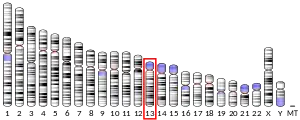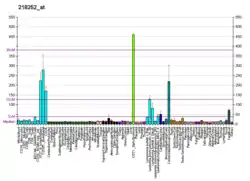CKAP2
Cytoskeleton-associated protein 2 is a protein that in humans is encoded by the CKAP2 gene.[5][6]
| CKAP2 | |||||||||||||||||||||||||||||||||||||||||||||||||||
|---|---|---|---|---|---|---|---|---|---|---|---|---|---|---|---|---|---|---|---|---|---|---|---|---|---|---|---|---|---|---|---|---|---|---|---|---|---|---|---|---|---|---|---|---|---|---|---|---|---|---|---|
| Identifiers | |||||||||||||||||||||||||||||||||||||||||||||||||||
| Aliases | CKAP2, LB1, TMAP, se20-10, cytoskeleton associated protein 2 | ||||||||||||||||||||||||||||||||||||||||||||||||||
| External IDs | OMIM: 611569 MGI: 1931797 HomoloGene: 10070 GeneCards: CKAP2 | ||||||||||||||||||||||||||||||||||||||||||||||||||
| |||||||||||||||||||||||||||||||||||||||||||||||||||
| |||||||||||||||||||||||||||||||||||||||||||||||||||
| |||||||||||||||||||||||||||||||||||||||||||||||||||
| |||||||||||||||||||||||||||||||||||||||||||||||||||
| Wikidata | |||||||||||||||||||||||||||||||||||||||||||||||||||
| |||||||||||||||||||||||||||||||||||||||||||||||||||
Human CKAP2 gene, the cDNA of which is known as LB1, is a cytoskeleton-associated protein involved in mitotic progression. Its high transcriptional activity has been observed in the testes, thymus, and diffuse B-cell lymphomas. The gene codes for a protein of 683 residues, which lacks a homology to known amino acid sequences. On evidence of immunofluorescence analysis, the CKAP2 product is a cytoplasmic protein associated with cytoskeletal fibrils. The CKAP2 gene is in chromosome 13q14. Rearrangements of this region result in various tumors. Thus deletions have been detected in multiple myeloma, prostate cancer, head-and-neck squamous-cell carcinoma, B-cell prolymphocytic leukemia, non-Hodgkin lymphoma, and in more than half cases of B-cell chronic lymphocytic leukemia.
References
- GRCh38: Ensembl release 89: ENSG00000136108 - Ensembl, May 2017
- GRCm38: Ensembl release 89: ENSMUSG00000037725 - Ensembl, May 2017
- "Human PubMed Reference:". National Center for Biotechnology Information, U.S. National Library of Medicine.
- "Mouse PubMed Reference:". National Center for Biotechnology Information, U.S. National Library of Medicine.
- Maouche-Chretien L, Deleu N, Badoual C, Fraissignes P, Berger R, Gaulard P, Romeo PH, Leroy-Viard K (Oct 1998). "Identification of a novel cDNA, encoding a cytoskeletal associated protein, differentially expressed in diffuse large B cell lymphomas". Oncogene. 17 (10): 1245–51. doi:10.1038/sj.onc.1202048. PMID 9771967.
- "Entrez Gene: CKAP2 cytoskeleton associated protein 2".
Alternative titles: tumor- and microtubule-associated protein; TMAP, LB1
External links
- Human CKAP2 genome location and CKAP2 gene details page in the UCSC Genome Browser.
Further reading
- Eichmuller S, Usener D, Dummer R, et al. (2001). "Serological detection of cutaneous T-cell lymphoma-associated antigens". Proc. Natl. Acad. Sci. U.S.A. 98 (2): 629–34. doi:10.1073/pnas.021386498. PMC 14639. PMID 11149944.
- Wiemann S, Weil B, Wellenreuther R, et al. (2001). "Toward a Catalog of Human Genes and Proteins: Sequencing and Analysis of 500 Novel Complete Protein Coding Human cDNAs". Genome Res. 11 (3): 422–35. doi:10.1101/gr.GR1547R. PMC 311072. PMID 11230166.
- Udina IG, Baranova AV, Kompaniĭtsev AA, Sulimova GE (2001). "[Evolutionarily-conserved gene CKAP2,located in region 13q14.3 of the human genome, is frequently rearranged in various tumors]". Genetika. 37 (1): 120–3. PMID 11234418.
- Strausberg RL, Feingold EA, Grouse LH, et al. (2003). "Generation and initial analysis of more than 15,000 full-length human and mouse cDNA sequences". Proc. Natl. Acad. Sci. U.S.A. 99 (26): 16899–903. Bibcode:2002PNAS...9916899M. doi:10.1073/pnas.242603899. PMC 139241. PMID 12477932.
- Rakhmanaliev ER, Klimov EA, Kompaniĭtsev AA, Sulimova GE (2003). "[The structure of the human oncogenesis-associated CKAP2 (LB1) gene]". Mol. Biol. (Mosk.). 36 (6): 985–9. PMID 12500535.
- Bae CD, Sung YS, Jeon SM, et al. (2004). "Up-regulation of cytoskeletal-associated protein 2 in primary human gastric adenocarcinomas". J. Cancer Res. Clin. Oncol. 129 (11): 621–30. doi:10.1007/s00432-003-0484-0. PMID 12942315. S2CID 22334193.
- Ota T, Suzuki Y, Nishikawa T, et al. (2004). "Complete sequencing and characterization of 21,243 full-length human cDNAs". Nat. Genet. 36 (1): 40–5. doi:10.1038/ng1285. PMID 14702039.
- Dunham A, Matthews LH, Burton J, et al. (2004). "The DNA sequence and analysis of human chromosome 13". Nature. 428 (6982): 522–8. Bibcode:2004Natur.428..522D. doi:10.1038/nature02379. PMC 2665288. PMID 15057823.
- Jin J, Smith FD, Stark C, et al. (2004). "Proteomic, functional, and domain-based analysis of in vivo 14-3-3 binding proteins involved in cytoskeletal regulation and cellular organization". Curr. Biol. 14 (16): 1436–50. doi:10.1016/j.cub.2004.07.051. PMID 15324660. S2CID 2371325.
- Gerhard DS, Wagner L, Feingold EA, et al. (2004). "The Status, Quality, and Expansion of the NIH Full-Length cDNA Project: The Mammalian Gene Collection (MGC)". Genome Res. 14 (10B): 2121–7. doi:10.1101/gr.2596504. PMC 528928. PMID 15489334.
- Nousiainen M, Silljé HH, Sauer G, et al. (2006). "Phosphoproteome analysis of the human mitotic spindle". Proc. Natl. Acad. Sci. U.S.A. 103 (14): 5391–6. Bibcode:2006PNAS..103.5391N. doi:10.1073/pnas.0507066103. PMC 1459365. PMID 16565220.
- Jeon SM, Choi B, Hong KU, et al. (2006). "A cytoskeleton-associated protein, TMAP/CKAP2, is involved in the proliferation of human foreskin fibroblasts". Biochem. Biophys. Res. Commun. 348 (1): 222–8. doi:10.1016/j.bbrc.2006.07.046. PMID 16876122.
- Hong KU, Park YS, Seong YS, et al. (2007). "Functional Importance of the Anaphase-Promoting Complex-Cdh1-Mediated Degradation of TMAP/CKAP2 in Regulation of Spindle Function and Cytokinesis". Mol. Cell. Biol. 27 (10): 3667–81. doi:10.1128/MCB.01386-06. PMC 1900002. PMID 17339342.
- Seki A, Fang G (2007). "CKAP2 is a spindle-associated protein degraded by APC/C-Cdh1 during mitotic exit". J. Biol. Chem. 282 (20): 15103–13. doi:10.1074/jbc.M701688200. PMID 17376772.




